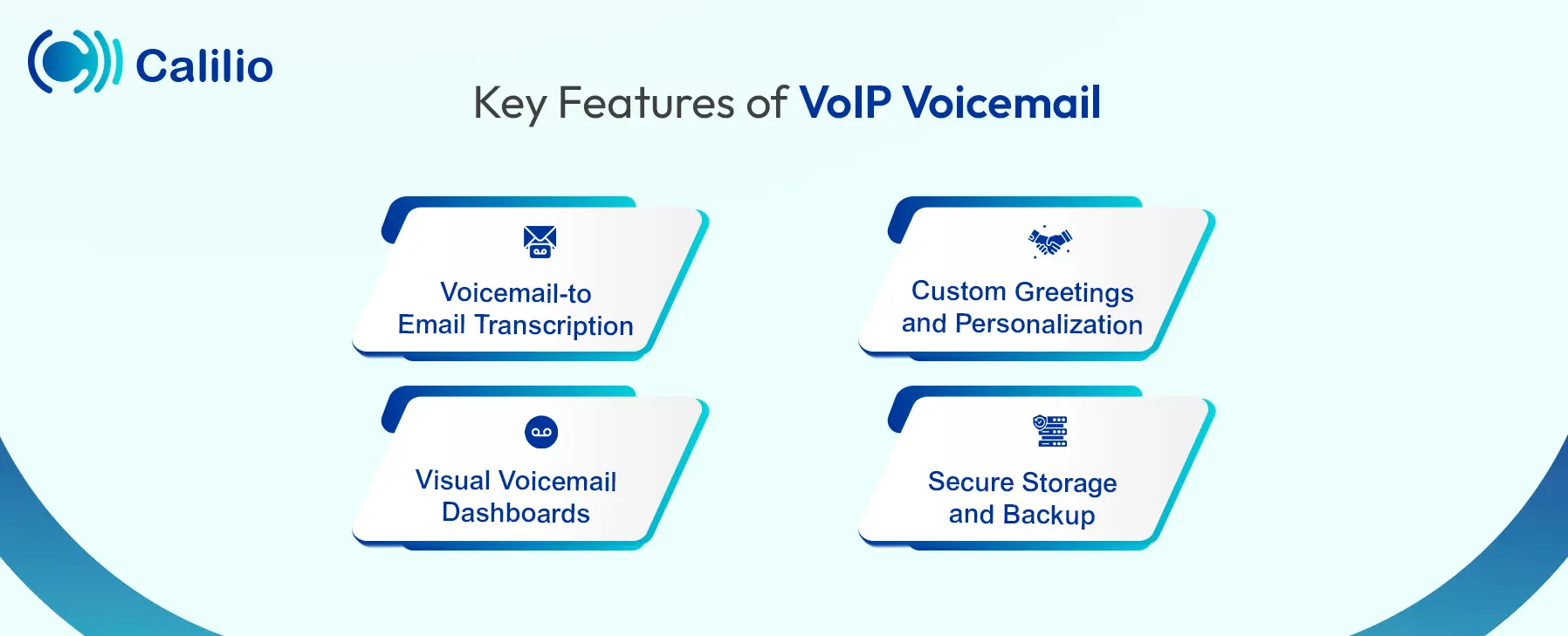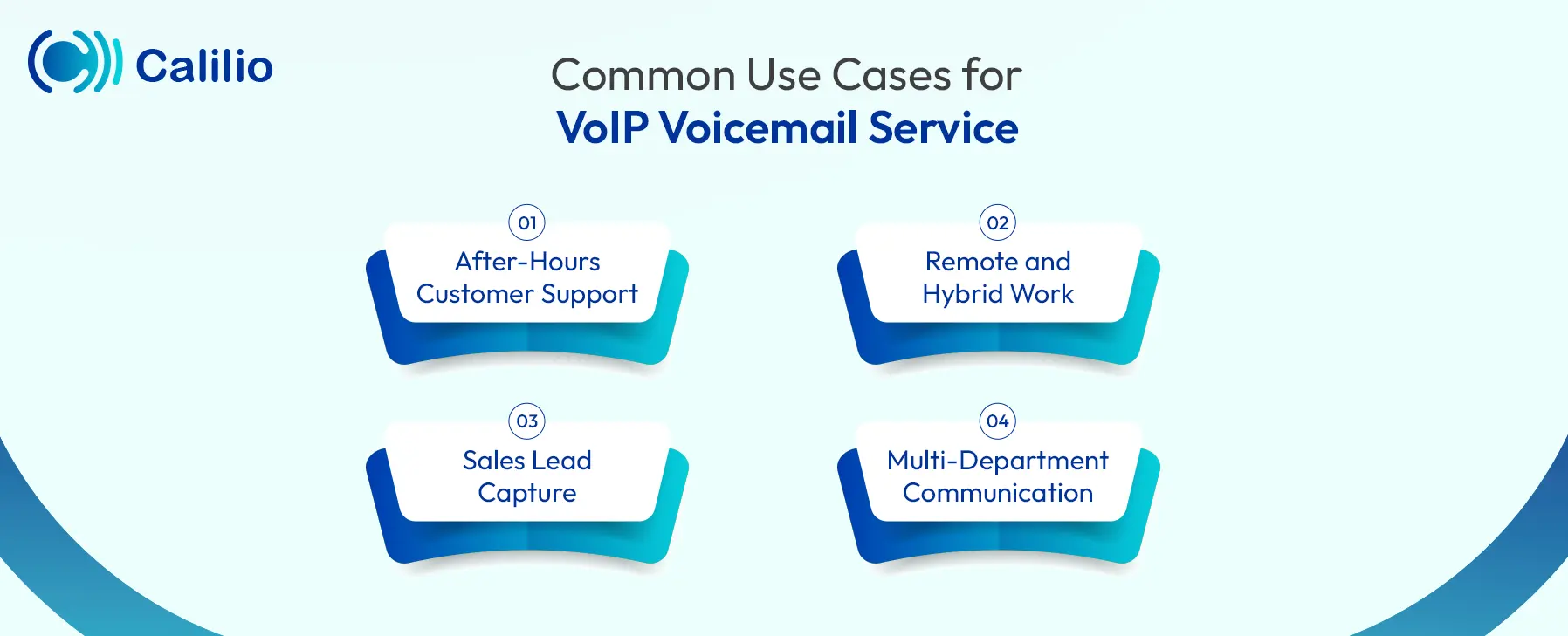What is a VoIP Voicemail and How to Set It Up?

Voicemail allows the caller to leave a message when you can’t pick up the call. But traditional voicemail comes with its own limitations. They’re hard to access remotely and lack real-time notifications. As a result, important messages can go unnoticed or unanswered for too long.
VoIP voicemail, as a cloud-based solution, solves this problem. With VoIP voicemail, you can access and manage messages, receive alerts via email or app, all from a unified dashboard, no matter where you are.
In this blog, we’ll explore everything you need to know about VoIP voicemail, including its benefits, key features, and setup tips.
Key Highlights:
VoIP voicemail is a digital voicemail system that securely stores messages in the cloud for access from any device.
The key features of VoIP voicemail service include voicemail-to-email, voicemail transcription, and a custom greeting for callers.
Voicemail improves response times with instant alerts, remote access, and a flexible retrieval option.
VoIP voicemail is especially useful for after-hours customer support, sales leads, and managing distributed remote teams.
What is VoIP Voicemail?
VoIP voicemail is a modern, digital voicemail system integrated with VoIP (Voice over Internet Protocol) phone systems. Instead of storing messages on a physical phone or carrier server, it saves them in the cloud, making them accessible from anywhere with an internet connection.
Users can listen to, download, or manage messages through a web portal, mobile app, or email. Moreover, many VoIP voicemail systems also include advanced features like voicemail-to-email delivery, message transcription, and custom greetings. This provides more flexibility, faster response times, and better message organization compared to traditional voicemail.
How Does Voicemail Work in VoIP?
Voicemail in VoIP works by digitally recording the voice messages and storing them on your provider’s cloud-based servers rather than on a traditional telephone system. When you don’t answer the call on your VoIP number, it goes to your voicemail, where the system records the message and saves it online so you can access it anytime.
Here’s how it works:
- Step 1: The VoIP phone system forwards the unanswered call to your voicemail service.
- Step 2: The caller hears your pre-recorded greeting (e.g., “Hi, you’ve reached [Your Name]. Please leave a message”).
- Step 3: The system records the caller’s voice message and stores it in digital format on your VoIP provider’s server.
- Step 4: Your VoIP system sends you notifications via email, text, or app alerts when you have a new voicemail.
- Step 5: You can access, play, delete, forward, or download voicemail from anywhere through a VoIP desk phone, mobile app, email, or a web dashboard.
Traditional Voicemail vs. VoIP Voicemail: Key Differences
Traditional voicemail stores messages on physical hardware linked to a landline system, often limiting access to specific devices and locations. In contrast, VoIP voicemail is cloud-based, allowing you to access, manage, and respond to messages from any device with an internet connection.
Here are the key differences between them:
Feature | Traditional Voicemail | VoIP Voicemail |
| Technology | Uses the phone company’s analog or digital landline network. | Uses internet-based VoIP systems. |
| Access Method | Usually requires dialing a specific number and entering a PIN from your phone. | Can be accessed via phone, email, web portal, or mobile app. |
| Storage | Stored on your telephone provider’s voicemail server, with limited capacity (often deletes older messages automatically). | Stored on cloud servers with larger or customizable storage limits. |
| Retrieval | Voicemails can be retrieved only from the phone linked to the number (or remote dial-in if supported). | Can be retrieved from anywhere with internet access. |
| Transcription | Rarely available; usually just audio. | Often includes voicemail-to-text or voicemail-to-email transcription. |
| Notifications | Typically indicated by a “stutter” dial tone or voicemail light. | Instant notifications via email, SMS, or app push alerts. |
| Integration | Works only with the phone line it’s tied to. | Integrates with CRM, email, team chat apps, and unified communications platforms. |
Key Features of VoIP Voicemail
VoIP voicemail service offers numerous features for efficient management of voicemails, including voicemail-to-email transcription, customizable greetings, visual voicemail dashboards, and secure storage with backup. These features make it easier to access messages from anywhere, respond faster, and personalize caller experiences, while ensuring data security.

1. Voicemail-to-Email Transcription
Voicemail-to-email transcription is a VoIP feature that converts a caller’s voice message into written text and sends it to your email. It lets you quickly read the message without listening to the audio, making it easier to scan, search, and reference important details anytime.
2. Custom Greetings and Personalization
You can record tailored voicemail messages for different situations. Some VoIP systems even let you personalize greetings for specific callers or groups. This not only improves professionalism but also sets clear expectations for response times and keeps communication consistent with your brand tone.
3. Visual Voicemail Dashboards
A visual voicemail dashboard is a VoIP feature that organizes your voicemail messages in a clear, on-screen list, so you can see caller details, timestamps, and message length at a glance. It often includes playback controls, voicemail-to-text previews, and options to delete, forward, or download messages without dialing in.
4. Secure Storage and Backup
VoIP voicemail saves all your messages on encrypted servers and protects them from unauthorized access. Most service providers also offer automatic backups, so you can recover messages if they are accidentally deleted or if there’s a system failure.
What are the Benefits of VoIP Voicemail?
VoIP voicemail lets you access messages remotely, receive instant notifications, securely store data, and easily keep track of important messages across devices. Moreover, features like voicemail transcription help save time, while custom greetings help you maintain a professional caller experience.
- Remote Access: You can access your voicemails from anywhere and any device with an internet connection. This is especially beneficial if you work remotely or travel frequently.
- Faster Response Times: As soon as a voicemail arrives, you get instant notifications via email, text, or app alerts, helping you respond promptly to clients or colleagues.
- Improved Organization: Since the received voicemails are stored digitally, you can search them by caller, date, or keywords (if transcription available). This makes it way easier to track important messages and follow up.
- Better Productivity: Features like voicemail-to-email and voicemail transcription let you read messages at a glance without playing audio, saving time and effort.
- Professional Communication: Custom greetings give you control over what callers hear, helping you maintain a consistent brand image and provide useful information, like office hours or alternative contact options.
- Data Security: Messages are stored on encrypted servers, with backup options. As such, your voicemails remain protected against unauthorized access or system failures.
Don’t Let Another Important Call Go Unanswered.
Start Using Calilio’s Advanced VOIP Voicemail Today
How To Set Up Voicemail on a VoIP Phone?
To set up VoIP voicemail, open your VoIP app, navigate to the voicemail settings section, and activate voicemail after customizing your greeting.
The VoIP voicemail setup process varies depending on your VoIP provider and phone model, but it usually follows a similar pattern.
- Step 1: Open your VoIP app and look for the voicemail or message section in the app’s menu and tap it.
- Step 2: Choose the option to record a greeting and record your personal greeting clearly.
- Step 3: Enable voicemail-to-email if you want messages sent to your inbox.
- Step 4: Set message retention/deletion preferences (for example: “delete after 30 days”) in the settings.
- Step 5: Enable remote access and set a remote access PIN to listen to messages from another phone.
- Step 6: Save or confirm all changes and exit the voicemail menu.
Common Use Cases for VoIP Voicemail Service
VoIP voicemail service is primarily used for after-hours support, remote teams, sales leads, and managing messages across departments or time zones. It helps businesses stay responsive and organized even when teams aren’t immediately available.

- After-Hours Customer Support: When your office is closed, VoIP voicemail service ensures customers can still leave messages. You can set custom voicemail greetings to welcome your customers and ask them to leave a message. In the greetings, you can also include information about your working hours and alternative contact methods.
- Remote and Hybrid Work: Teams working from different locations can access voicemails from any device. This makes it easier for remote employees to stay updated and respond quickly, no matter where they are.
- Sales Lead Capture: If a sales call is missed, VoIP voicemail records the lead’s message and contact details. And, with the voicemail-to-email feature, sales teams can follow up on the messages instantly.
- Multi-department Communication: VoIP systems allow separate voicemail boxes for departments (e.g., sales, support, billing), making it easier to route messages to the right team without delay.
Conclusion
Missed calls can lead to missed opportunities, especially when it comes to critical clients and urgent updates. With a proper VoIP voicemail setup, you get instant alerts, secure storage, and access from any device. So, you can respond faster, stay organized, and maintain a professional image.

Get Cashbacks Up to 43% Straight To Your Wallet!
Unlimited Virtual Numbers – Local, Mobile & Toll-Free from 100+ Countries
Free Local Phone Number from US or Canada
Crystal-Clear Calls Starting at Just $0.0153/min
24/7 Human Support – Because Great Service Never Takes a Holiday


Frequently Asked Questions
What do I dial to access voicemail in a VoIP phone?
To access your voicemail in a VoIP phone system, you typically dial \*98 or \*97 from your VoIP phone. You may also need to provide your voicemail password to access your message.
How do I turn off voicemail on VoIP?

Still have questions?
Can’t find the answer you’re looking for? Please chat with our friendly team.
Stay in the loop
Get the latest call insights, trends, and updates delivered straight to your inbox.
By subscribing, you agree to receive updates from Calilio.
You can unsubscribe anytime.